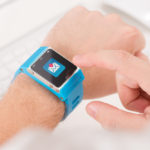Smartwatches and other wearables, wearable technology
Smartwatches are a wearable technology, but the idea of miniaturizing technology so we can carry it around with us is nothing new, but simply a response to our desire to make technology part of our daily lives.

Today smartwatches and other wearables are seen as the height of modernity, a way of making technology part of our daily lives, of our private world. We carry our cell phone around in our bags or in our pockets, we leave it lying on the table, but our watch is with us at all times. It's attached to our wrist, and we often even sleep with it on. Making it smart only means inviting technology one step further into our private lives, as we always wanted to be more technological.
Supercomplication
We don't know when it started, but it's well known that the American millionaires James Ward Packard and Henry Graves competed to come up with the most complicated watch in existence. Before cell phones, the most advanced piece of technology we carried around with us was the wristwatch, and before that the pocket watch. Many people continue to be fascinated by that mechanical microcosm, even though the quartz watches of today keep much better time than in the past.
In watchmaking, each additional function of a mechanical watch is known as a complication. Packard had the most complicated watch in the world since 1927, and Henry Graves in 1933 was charged with manufacturingthe supercomplication, the most complex pocket watch ever made. The watch took three years to design, and five to build. It had 24 complications, including a map showing the position of the stars from Graves' home in New York.
The digital wrist
After the Second World War, pocket watches were replaced with wristwatches. These remained unchanged for decades –until the introduction of quartz watches, which didn't need to be wound every night, and were more accurate and cheaper.
The arrival of digital watches included some with functions like games, calculators and remote control. But they never succeeded in replacing analog watches. The classic watches with hands were considered much more elegant

Wearables
According to the IDC 19.2 million were sold in 2014, three times the previous year. And it is estimated that sales of wearable devices will hit 111.9 billion by 2020. This institution classifies them into complex accessories (like activity tracker wristbands), smart accessories (dependent on another device like a smartphone or tablet) and smartwearables, like Google Glass (which are independent except for Internet access).
From the start, many wearables have been associated with health and physical activity, as well as with increasing the information we have available at any time. They're also a way of sharing what we're doing with our circle of friends and family or with the world at large. We can share the calories we've burnt, the routes we've taken, or our experiences, thanks to wearables like cameras designed to record our sporting activity.
Wearables are finding they have to provide something more than the old digital watches. They don't just offer a single function, but many. They're going to help us with what's becoming our main obsession –our health–, they're going to help with our favorite activities, they're going to be used in our financial transactions, and for anything else we want.
In the end, wearables are just a further manifestation of the trend to incorporate microcomputers into every aspect of our lives. Our cars already feature several that help us drive more safely and consume less fuel, our TV's are beginning to incorporate them, and of course our smart phone is more like a computer with a touchscreen that can also be used to make phone calls.
On the other hand, they're going to have to overcome a number of obstacles, just as the first cell phones and wristwatches did. They also have to meet the challenge that digital watches never did,that of being considered cceptable by everyone in any situation, and not just as a technological eccentricity.
Opportunities in apps for wearables
Of course as they become more widespread they're going to spawn an interesting apps ecosystem and numerous opportunities for entrepreneurs who can pinpoint a gap or innovate in the way an existing need can be met more effectively by our wearable device. According to Gartnet, in 2013 alone, over 100 billion apps were downloaded all over the world.
Spain may be a culture medium for apps for wearables. It is the European country with the highest smartphone ownership, and 22 million people use apps on a daily basis.What's more, 4 million apps are downloaded every day. The 10 most successful Spanish apps account for over two million downloads. Cities like Madrid and particularly Barcelona are becoming European references for app development. If wearables turned out to have similar figures, we would have a market and a developers' ecosystem that would be ideal for entrepreneurs capable of spotting opportunities in wearables.
Wearables are not only a chance to make our technological dreams come true, but just as the Swiss watchmakers seized the opportunity to sell us the mechanics on our wrist, now there's similar potential to sell us the software for our wearable device.